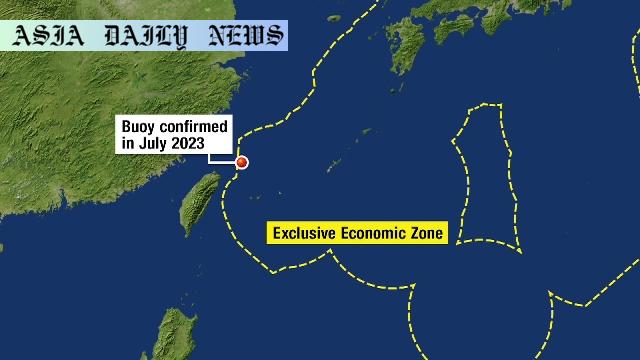Senkaku Islands: Japanese coast guard confirms removal of a Chinese buoy from its exclusive economic zone near the disputed area.
Senkaku Islands: A Chinese-installed buoy in Japan’s EEZ has been confirmed to be removed.
Japan asserts the installment violates international maritime laws under UNCLOS.
China claims the buoy’s installation and removal follow both domestic and international regulations.
The territorial disputes over the Senkaku Islands remain a sensitive issue.

Background of the Senkaku Islands Dispute
The Senkaku Islands, a group of uninhabited islands located in the East China Sea, have been at the heart of territorial disputes involving Japan, China, and Taiwan. These islands are strategically significant, not only in terms of regional control but also due to potential natural resources in the surrounding waters. Japan controls these islands and regards them as an integral part of its territory under historical and international law. However, both China and Taiwan claim sovereignty over them, leading to ongoing contention.
Chinese Buoy Triggers Tension
In July 2023, the Japanese Coast Guard detected a Chinese-installed buoy within Japan’s exclusive economic zone (EEZ) northwest of Okinawa Prefecture’s Senkaku Islands. Japan issued warnings about the buoy, highlighting its presence as a potential violation of the United Nations Convention on the Law of the Sea (UNCLOS), which prohibits installing structures in a foreign EEZ without consent. The Japanese government formally demanded the buoy’s removal, considering it a breach of international maritime laws.
Removal Confirmed: A Step Forward?
On Tuesday, Japanese coast guard officials confirmed the buoy’s removal, marking a significant development in the maritime dispute. The buoy had been a contentious issue since 2023, leading to diplomatic protests and heightened scrutiny of the waters near the Senkaku Islands. While Japan issued a new warning to vessels confirming the buoy’s absence, China revealed through its Foreign Ministry spokesperson, Guo Jiakun, that the removal was voluntary. According to China, the buoy had fulfilled its purpose for scientific observation, and its withdrawal was a result of technical adjustments.
China’s Justification
China has consistently defended its actions in the region. Spokesperson Guo Jiakun reiterated that both the installation and removal of the buoy complied with domestic and international legal protocols. Despite the tensions, China framed the buoy’s presence as related to scientific observation rather than asserting territorial claims. However, such actions are perceived by Japan as an infringement on their sovereign rights and a tactic to establish a de facto presence in disputed waters.
Continuing Disputes: A New Buoy Detected
Even as this issue sees resolution, another Chinese-installed buoy has been detected south of Okinawa Prefecture’s Yonaguni Island, well within Japan’s EEZ. This recent finding reignites tensions. Japan’s Foreign Minister Iwaya Takeshi demanded its immediate removal during discussions with China’s Foreign Minister Wang Yi in December. Such recurrent actions underline the persistent fragility of Sino-Japanese relations concerning maritime boundaries.
Implications for Regional Stability
The removal of the buoy signals a temporary de-escalation, but the fundamental issues concerning territorial rights over the Senkaku Islands remain unresolved. Experts suggest that such incidents should prompt dialogue rather than heated exchanges. The region’s stability depends on the ability of Japan, China, and Taiwan to address underlying disagreements while adhering to international law.
Conclusion
The Senkaku Islands’ territorial disputes remain emblematic of broader tensions in East Asian geopolitics. While the confirmed removal of the buoy is a positive step, it serves as a reminder of the complex dynamics at play. Both nations must navigate these contentious waters carefully to prevent further escalation and move towards a peaceful resolution.



Commentary
The Significance of the Senkaku Islands Dispute
The Senkaku Islands represent more than just uninhabited landmasses in the East China Sea—they are a symbol of national sovereignty and regional power for Japan, China, and Taiwan. The ongoing tension surrounding these islands serves as a reminder of the complex geopolitical realities in East Asia. While Japan sees these islands as an intrinsic part of its territory, both history and international law are interpreted differently by China and Taiwan. This level of contention underscores how deeply historical narratives intertwine with modern geopolitics.
China’s Strategy and Japan’s Pushback
China’s decision to install buoys in disputed waters reflects a broader strategy to assert its regional dominance and influence. While branded as scientific observation tools, such actions raise alarms regarding territorial encroachments. Japan, on the other hand, has responded with diplomatic protests and legal references to UNCLOS, emphasizing its commitment to international norms. However, Japan’s actions also highlight its imperative to project strong sovereignty claims, especially in face of an assertive neighbor like China.
What Lies Ahead?
The removal of the Chinese buoy near the Senkaku Islands offers a temporary sigh of relief but is far from a resolution. Instead, it opens the door to greater diplomatic engagement or, alternatively, renewed provocations. As both nations vie for influence in the region, collaborative solutions seem elusive. Yet, one truth remains clear: maintaining regional stability and avoiding further escalation requires both sides to engage in constructive dialogue rather than unilateral actions. The world will undoubtedly watch how this delicate situation unfolds in the coming months.